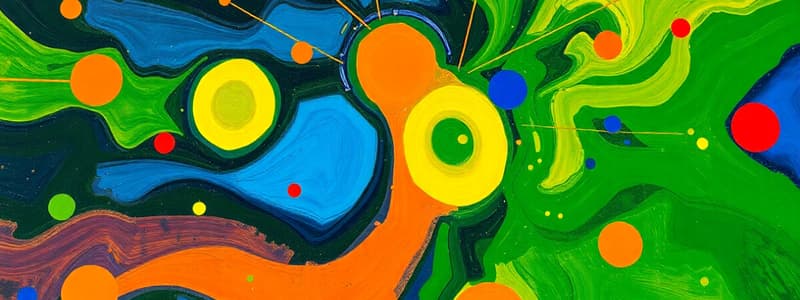Podcast
Questions and Answers
What is unique about chromatic colours in relation to object properties?
What is unique about chromatic colours in relation to object properties?
- They are perceived the same regardless of the light source.
- They result from the selective reflection or transmission of wavelengths. (correct)
- They are only applicable to transparent objects.
- They result from equal reflection of all wavelengths.
Which of the following best describes how achromatic colours are produced?
Which of the following best describes how achromatic colours are produced?
- Equal reflection or transmission of all wavelengths. (correct)
- Selective transmission of all wavelengths.
- Selective absorption of all wavelengths.
- A combination of selective reflection and transmission.
What distinguishes 'hue' from 'saturation' and 'brightness' in describing color?
What distinguishes 'hue' from 'saturation' and 'brightness' in describing color?
- Hue refers to the intensity of light, while saturation refers to color value.
- Hue describes the intensity of the color, while brightness describes the color value.
- Hue represents the color value, while saturation is the amount of white added to the color. (correct)
- Hue is the amount of light reflected, while brightness is the purity of the color.
How does additive colour mixture differ from subtractive colour mixture?
How does additive colour mixture differ from subtractive colour mixture?
What is the fundamental concept behind the trichromatic theory of colour vision?
What is the fundamental concept behind the trichromatic theory of colour vision?
What was the key finding from Helmholtz's colour-matching experiments that supported the trichromatic theory?
What was the key finding from Helmholtz's colour-matching experiments that supported the trichromatic theory?
How do S, M, and L cones contribute to colour vision, according to the trichromatic theory?
How do S, M, and L cones contribute to colour vision, according to the trichromatic theory?
What is the key characteristic of monochromatism?
What is the key characteristic of monochromatism?
What defines dichromatism in terms of cone function?
What defines dichromatism in terms of cone function?
What is tetrachromacy and how does it differ from trichromacy?
What is tetrachromacy and how does it differ from trichromacy?
What is the central idea behind the opponent-process theory of colour vision?
What is the central idea behind the opponent-process theory of colour vision?
According to the opponent-process theory, what creates the perception of complementary afterimages?
According to the opponent-process theory, what creates the perception of complementary afterimages?
What is the functional role of 'single-opponent' neurons in visual processing, according to the opponent process theory?
What is the functional role of 'single-opponent' neurons in visual processing, according to the opponent process theory?
What role do 'double-opponent' neurons play in colour vision?
What role do 'double-opponent' neurons play in colour vision?
How do the trichromatic and opponent-process theories of colour vision complement each other?
How do the trichromatic and opponent-process theories of colour vision complement each other?
If a transparent object appears achromatic, what can be inferred about its interaction with light?
If a transparent object appears achromatic, what can be inferred about its interaction with light?
In the context of colour perception, what does "Weber's discrimination threshold" refer to?
In the context of colour perception, what does "Weber's discrimination threshold" refer to?
A painter mixes two different pigments, resulting in a new colour. What type of colour mixture is this, and what principle governs the resulting colour?
A painter mixes two different pigments, resulting in a new colour. What type of colour mixture is this, and what principle governs the resulting colour?
What physiological evidence supports the trichromatic theory of colour vision?
What physiological evidence supports the trichromatic theory of colour vision?
An individual is unable to distinguish between red and green. According to the impaired colour vision conditions, which condition best describes this?
An individual is unable to distinguish between red and green. According to the impaired colour vision conditions, which condition best describes this?
What is the most accurate description of how colour enhances perceptual organisation:
What is the most accurate description of how colour enhances perceptual organisation:
Which of the following is an accurate statement regarding how the brain processes information about colour?
Which of the following is an accurate statement regarding how the brain processes information about colour?
Which of the following best defines the term sensation?
Which of the following best defines the term sensation?
Which of the following is the most accurate definition of "the visible light spectrum"?
Which of the following is the most accurate definition of "the visible light spectrum"?
A scientist discovers a new species of animal that possesses four different types of cones in their eyes. Based on this information, what can be inferred?
A scientist discovers a new species of animal that possesses four different types of cones in their eyes. Based on this information, what can be inferred?
Regarding the trichromatic theory of colour vision, which researcher(s) is/are most strongly associated with?
Regarding the trichromatic theory of colour vision, which researcher(s) is/are most strongly associated with?
Why are there no colours that can be described as blueish-yellow or reddish-green?
Why are there no colours that can be described as blueish-yellow or reddish-green?
According to the opponent-process theory, what happens when you adapt to black?
According to the opponent-process theory, what happens when you adapt to black?
Which of the following statements accurately describes the trichromatic theory:
Which of the following statements accurately describes the trichromatic theory:
Which of the following represents the correct order in which the visual information is processed with regards to colour vision:
Which of the following represents the correct order in which the visual information is processed with regards to colour vision:
Of the following examples, which is processed by single-opponent receptive fields?
Of the following examples, which is processed by single-opponent receptive fields?
Which statement(s) relate to the functions of the opponent visual neurons with double-opponent receptive fields (select all that apply):
Which statement(s) relate to the functions of the opponent visual neurons with double-opponent receptive fields (select all that apply):
Which of the following is an accurate statement regarding wavelengths and perceived colour:
Which of the following is an accurate statement regarding wavelengths and perceived colour:
Of the following colours, which can be descibed as pure colours?
Of the following colours, which can be descibed as pure colours?
If a solid object equally reflects all wavelengths, what colour would this be?
If a solid object equally reflects all wavelengths, what colour would this be?
With regards to the different cone types responding, which statement is correct?
With regards to the different cone types responding, which statement is correct?
What type of vision are people with monochromatism likely to experience?
What type of vision are people with monochromatism likely to experience?
Which of the following descriptions are related to impairments of dichromatism?
Which of the following descriptions are related to impairments of dichromatism?
What is the fundamental difference between sensation and perception?
What is the fundamental difference between sensation and perception?
How does top-down processing influence colour perception?
How does top-down processing influence colour perception?
What is the significance of colour being described as 'non-veridical'?
What is the significance of colour being described as 'non-veridical'?
Which statement accurately contrasts chromatic and achromatic colours?
Which statement accurately contrasts chromatic and achromatic colours?
Which of the following accurately describes light transmission in transparent objects?
Which of the following accurately describes light transmission in transparent objects?
Why does mixing pigments result in subtractive colour mixture?
Why does mixing pigments result in subtractive colour mixture?
Colour-matching experiments are seen as key findings with regards to the trichromatic theory, but which statement represents its main conclusion?
Colour-matching experiments are seen as key findings with regards to the trichromatic theory, but which statement represents its main conclusion?
How do the responses of S, M, and L cones differ when perceiving the colour yellow?
How do the responses of S, M, and L cones differ when perceiving the colour yellow?
What distinguishes dichromatism from normal trichromatic vision?
What distinguishes dichromatism from normal trichromatic vision?
What is a key implication of the observation that there are no reddish-green or bluish-yellow colours?
What is a key implication of the observation that there are no reddish-green or bluish-yellow colours?
According to the opponent-process theory, how does the perception of afterimages arise?
According to the opponent-process theory, how does the perception of afterimages arise?
What is the functional role of single-opponent neurons with regards to colour vision?
What is the functional role of single-opponent neurons with regards to colour vision?
What is the function of double-opponent neurons?
What is the function of double-opponent neurons?
How does the trichromatic theory complement the opponent process theory in explaining colour vision?
How does the trichromatic theory complement the opponent process theory in explaining colour vision?
If two objects are perceived to be the same colour under varying lighting conditions, which perceptual phenomenon is most likely at play?
If two objects are perceived to be the same colour under varying lighting conditions, which perceptual phenomenon is most likely at play?
What is Weber's discrimination threshold and how does it relate to colour perception?
What is Weber's discrimination threshold and how does it relate to colour perception?
How does the brain process information of black and white achromatic colors?
How does the brain process information of black and white achromatic colors?
How does the number of cone types affect an animal's colour vision?
How does the number of cone types affect an animal's colour vision?
If a specific cone type is not functioning properly, what is likely to occur?
If a specific cone type is not functioning properly, what is likely to occur?
Regarding impairments of dichromatism, which of the following is most likely to occur?
Regarding impairments of dichromatism, which of the following is most likely to occur?
Which process is responsible for the perception of a lime as green?
Which process is responsible for the perception of a lime as green?
From the assumptions of the trichromatic theory of colour vision (Young and Helmholtz) it can be derived that:
From the assumptions of the trichromatic theory of colour vision (Young and Helmholtz) it can be derived that:
Which statement about colour vision is correct?
Which statement about colour vision is correct?
A man walks into a paint store looking for violet paint, but the store owner cannot create the colour for him. If he has normal colour vision, can you provide a likely reason for this?
A man walks into a paint store looking for violet paint, but the store owner cannot create the colour for him. If he has normal colour vision, can you provide a likely reason for this?
Flashcards
Sensation
Sensation
The creation of retinal images and electrical signals by the detection of a stimulus.
Perception
Perception
Making sense of retinal images and electrical signals.
Bottom-up guided perception
Bottom-up guided perception
Sensory input determines what is perceived. Describing structures.
Top-down guided perception
Top-down guided perception
Sensory input is interpreted to be perceived. Constructing perception by testing hypotheses.
Signup and view all the flashcards
What is colour?
What is colour?
Light does not contain colours, colour is how we perceive wavelengths.
Signup and view all the flashcards
Chromatic colours
Chromatic colours
When wavelengths are reflected selectively, giving the object colour.
Signup and view all the flashcards
Achromatic colours
Achromatic colours
When wavelengths are reflected equally
Signup and view all the flashcards
Hue
Hue
The colour quality, such as red, green, or blue
Signup and view all the flashcards
Saturation
Saturation
The amount of white added to the color
Signup and view all the flashcards
Brightness
Brightness
The amount of light reflected
Signup and view all the flashcards
Additive Colour Mixture
Additive Colour Mixture
All wavelengths present alone are also present when superimposed
Signup and view all the flashcards
Subtractive Colour Mixture
Subtractive Colour Mixture
Pigments absorbs the same wavelengths they absorb when they are alone - only the reflected wavelengths remain
Signup and view all the flashcards
Trichromatic theory
Trichromatic theory
Colour vision is based on the activity of three different receptor mechanisms(three different cone types)
Signup and view all the flashcards
Monochromatism
Monochromatism
No cones at all.
Signup and view all the flashcards
Dichromatism
Dichromatism
Only two types of cones.
Signup and view all the flashcards
Complementary afterimages
Complementary afterimages
Adapting to blue generates a yellow afterimage. Adapting to green generates a red afterimage. Adapting to black generates a white afterimage.
Signup and view all the flashcards
Opponent Channels
Opponent Channels
black/white-on/white-off; black-off/white-on
Signup and view all the flashcards
Single-opponent receptive fields
Single-opponent receptive fields
Neurons detects uniform colour surfaces.
Signup and view all the flashcards
Double-opponent receptive fields
Double-opponent receptive fields
Neurons are good at detecting colour boundaries.
Signup and view all the flashcardsStudy Notes
Sensation vs Perception
- Sensation refers to the retinal images and electrical signals created by the detection of a stimulus
- Perception is the process of making sense of the retinal images and electrical signals
Types of Perception
- Bottom-up guided perception: Sensory input determines what is perceived, involving describing and measuring, also known as structuralism
- Top-down guided perception: Sensory input is interpreted to construct perception by testing hypotheses, formulated by Gregory
Colour Enhancement
- Colour enhances perceptual organization, top-down control, and automatic bottom-up processing
What is Colour?
- The visible light spectrum ranges from approximately 400 nm (short wavelengths) to 700 nm (long wavelengths)
- Humans perceive different wavelengths as different colours
- Light does not contain colour and, therefore, colour is non-veridical
- Short wavelengths correspond to blue, medium to green, medium to long to yellow, and long to red
Colours of Objects
- Colours of solid objects are due to reflected wavelengths
- Chromatic colours result from selective reflection, where some wavelengths are reflected while others are absorbed
- Achromatic colours result from equal reflection, where all wavelengths are reflected
- Colours of transparent objects are due to transmitted wavelengths
- Chromatic colours in transparent objects result from selective transmission
- Achromatic colours in transparent objects result from equal transmission
Describing Colour
- Hue: Represents the colour value and is represented on the colour wheel; red, green, blue, and yellow are pure colours, and about 200 hues can be discriminated
- Saturation: Represents the amount of white added to the colour, ranging from saturated to non-saturated
- Brightness: The intensity of light reflected and the intensity (bright vs. dim)
- Humans can create around 7 million different colours using these three dimensions
- The Bureau of Standards identified 7500 colour names in 1976
Mixing Colours
- Mixing light involves additive colour mixture, where all wavelengths present alone are also present when other wavelengths are superimposed
- Mixing pigments involves subtractive colour mixture, where pigments absorb the same wavelengths whether alone or mixed, leaving only reflected wavelengths
Theories of Colour Vision
- Two theories regarding the nature of colour vision: Trichromatic theory and Opponent process theory
Trichromatic Theory
- Proposed by Thomas Young in 1802 and Hermann von Helmholtz in 1852, and is also known as the Young-Helmholtz theory of colour vision
- Colour-matching experiments by Helmholtz: Combines three lights to match colour shown on a test surface
- Any colour can be matched by adjusting proportions of three wavelengths
- Full colour vision is based on combining three different wavelengths
- Physiological evidence: Existence of S, M, and L cones which respond to short, medium, and long wavelengths, respectively
- Colour vision based on activity of three receptor mechanisms
- Trichromatism is having three different cone types
Impaired Colour Vision
- Monochromatism: No cones at all, resulting in perception of shades of brightness (white, grey, black), which is analogous to rod vision
- Dichromatism: Only two types of cones
- Different types of Dichromatism:
- Protanopia: Absence of L cones, resulting in red/green blindness
- Deuteranopia: Absence of M cones
- Tritanopia: Absence of S cones, resulting in blue/yellow blindness
- Tetrachromacy: Some animals have four types of cones and a four-dimensional colour space; Goldfish have cone types sensitive to red, green, blue, and ultraviolet light
Opponent-Process Theory
- Proposed by Ewald Hering in 1878
- Complementary afterimages: Adapting to blue generates a yellow afterimage and vice versa; adapting to green generates a red afterimage and vice versa; adapting to black generates a white afterimage and vice versa
- Selective colour deficiencies: red-green (Protanopia/Deuteranopia) or blue-yellow (Tritanopia)
- Red & green, blue & yellow, and black & white are paired
- Opponent channels: The opponent channels respond in opposite ways to different wavelengths
- Black/white: black-on/white-off; black-off/white-on
- Red/green: red-on/green-off; red-off/green-on
- Blue/yellow: blue-on/yellow-off; blue-off/yellow-on
- Physiological evidence: Opponent neurons in V1, V4, and Inferotemporal cortex
- Single-opponent: Neurons with single-opponent receptive fields are good at detecting uniform colour surfaces
- Double-opponent receptive fields are good at detecting colour boundaries
- Trichromatic and opponent-process theories are both correct.
Function of Cones and Neurons
- Light is reflected, and short wavelengths are absorbed
- S cones respond with M and L cones not responding
- The V1, V4, and IT: Blue on/yellow off cells respond resulting in perception
Studying That Suits You
Use AI to generate personalized quizzes and flashcards to suit your learning preferences.




